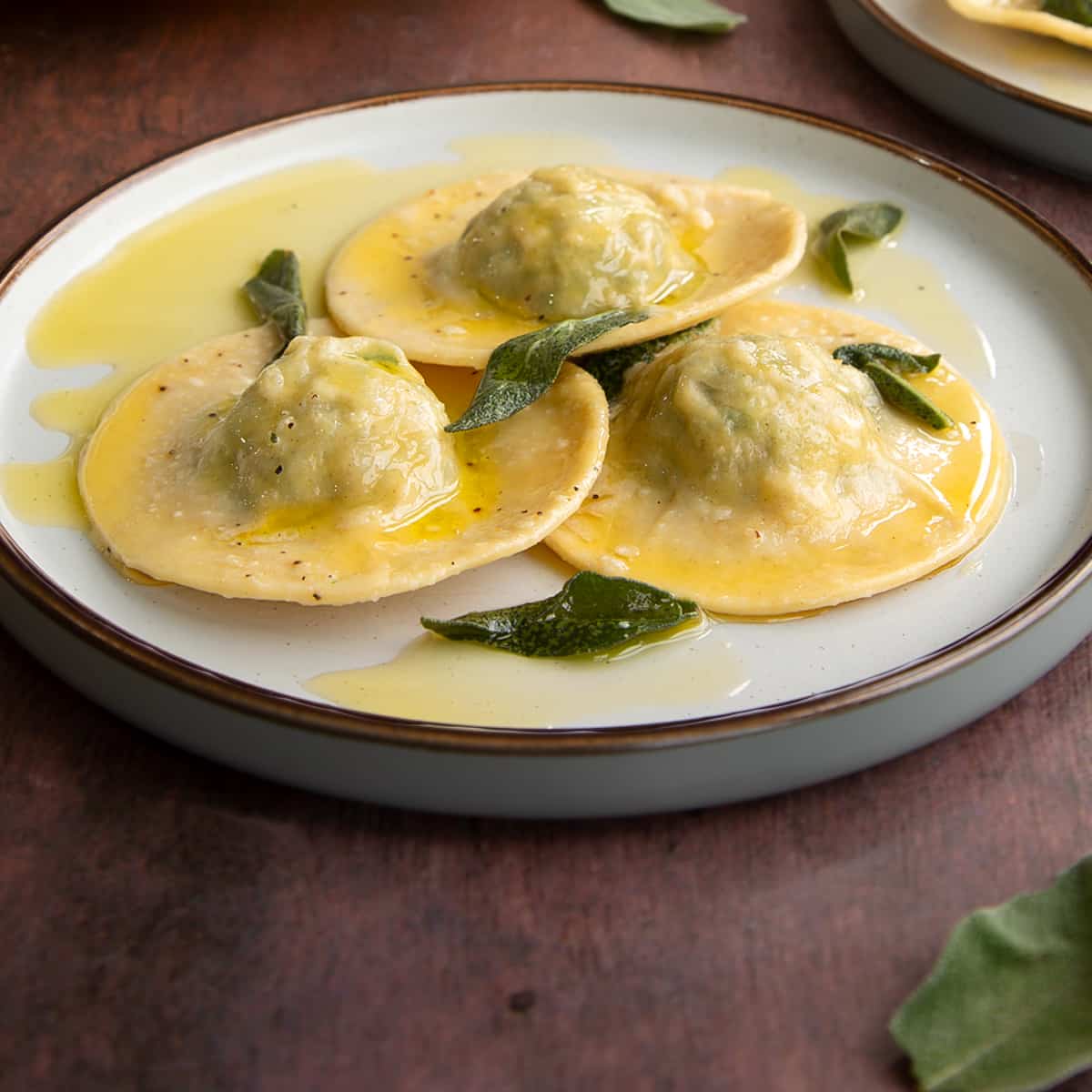Spinach and ricotta ravioli with sage butter
5.0
(3)
Your folders
Your folders
Prep Time: 30 minutes
Cook Time: 5 minutes
Total: 35 minutes
Servings: 16
Cost: $2.91 /serving
Author : Emily Leary

Ingredients
Export 11 ingredients for grocery delivery
Instructions
Step 1
Warm the oil in a pan and add the spinach, wilting for just 1-2 minutes.
Step 2
Take off the heat and tip onto a board or plate to cool. Don’t skip this step or the heat will make the filling too loose to work with.
Step 3
When the spinach is cold, press the excess liquid out, then chop roughly and transfer to a bowl.
Step 4
Put the ricotta, nutmeg, Parmesan and a pinch of salt and pepper in a bowl.
Step 5
Add the chopped spinach and stir together with a fork.
Step 6
Cover the bowl and put in the fridge to chill while you make the pasta.
Step 7
Start the pasta by adding the flour to a food processor bowl and pulsing the processor as you add the eggs one at a time until fully combined into a sticky, clumpy crumb.
Step 8
If it seems dry and isn’t clumping, you can pulse in a tablespoon of egg white.
Step 9
Turn out onto a clean surface and knead into a smooth dough.
Step 10
Cover with cling film and leave to rest for 20-30 minutes to make it easier to work with.
Step 11
Divide the pasta dough in half, working one piece at a time whilst keeping the other wrapped to prevent it from drying out.
Step 12
Shape the piece into a rectangle and set the pasta machine to its widest setting. Pass the pasta through the machine, then fold up and pass through again at 90 degrees from the folds. Repeat until you have a smooth sheet without tears, splits or dry patches.
Step 13
You can now reduce the number on your machine by one and pass the pasta through again twice. Keep working down the numbers, passing the pasta through twice each time and dusting with a tiny bit of flavour if it sticks until you are down to at least the penultimate setting (e.g. if your machine runs from 7 down to 1, then don't stop sooner than setting 2).
Step 14
Dust the underside of the strip very lightly with flour so that it doesn't stick and lay it out flat. Cut it in half so that you have two shorter strips, side by side.
Step 15
Spoon four tablespoons of filling along the length of the strip, well spaced apart.
Step 16
You now need to place pasta over the ricotta filling. You could do this my lifting the whole sheet, but I find it easiest to cut the sheets into fours so that I can place a square on top of each round of ricotta. Press all the way round firmly, making sure to press out any air out before sealing.
Step 17
Cut out each of the ravioli rounds using a large, plain-edged 9cm (3.5 inch) cookie cutter. A glass tumbler or knife will work too.
Step 18
Pull away the pasta offcuts and cover them to rest use later. Check your ravioli are sealed all around and press around the edges further if needed to seal.
Step 19
Sprinkle semolina generously on a tray and arrange the ravioli as you work, sprinkling more semolina on top too so that they don’t stick together
Step 20
Repeat with the remaining pasta dough and filling. Now gather up the rested offcuts and repeat the kneading and rolling process to produce more pasta you can fill with the remaining filling. You should get 16 in total.
Step 21
Leave them to firm a little while you make the sauce. If you’re not ready to cook them straight away, cover the tray loosely with clingfilm and place in the fridge for up to 48 hours.
Step 22
If you have leftover pasta dough after you've used up all your filling, you can gather it up, repeat the kneading process, put back through the machine and make some tagliatelle, which will keep in the fridge for 1-2 days.
Step 23
Bring a large pan of salted water to the boil.
Step 24
Put the salted butter in a large frying pan over a medium heat.
Step 25
Meanwhile, lower the ravioli into the boiling water. They will cook in just 4 minutes.
Step 26
Heat the butter gently until melted, then add the sage leaves and fry until they are sizzling, then add the lemon juice.
Step 27
Drain the pasta and add to the pan with the butter, basting to cover.
Step 28
Serve the pasta to plates, spooning some of the sage butter on top and serve immediately.